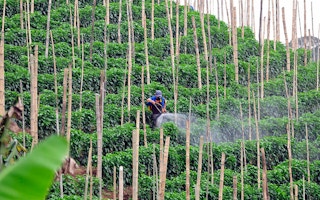A nano-sized bio-degradable clay-comprising double stranded ribonucleic acid (dsRNA) could offer a cost-effective, clean and green alternative to chemical-based plant pesticides.
Australian researchers from the University of Queensland have successfully used a gene-silencing spray, named BioClay, a combination of biomolecules and clay, to protect tobacco plants from a virus for 20 days with a single application. Their study has been published in Nature Plants.
“When BioClay is sprayed onto a plant, the virus-specific dsRNA is slowly released from the clay nanosheets into the plant. This activates a pathway in the plant that is a natural defence mechanism. The dsRNA is chopped up into small bits of RNA by enzymes of this pathway. These small bits attack the virus when it infects the plant without altering the plant genome,” explains lead researcher, Neena Mitter.
“Even with current pesticides, we lose up to 40 per cent of our crop productivity because of pests and pathogens. We are hoping that having BioClay in the mix as an environmentally friendly, sustainable crop protection measure will reduce crop losses,” Mitter adds.
While chemical-based pesticides kill the targeted insect, they can also affect a range of other insects that are beneficial. Mitter says, “BioClay is specific and it only kills the pathogen being targeted. Currently farmers use insecticides to kill the vector that comes with the viruses, but with BioClay we can target the virus itself.”
BioClay field trials may begin in Australia by year-end. “The first test will be on a virus that infects vegetable crops — capsicum, tomato, chilli,” Mitter tells SciDev.Net.
“
The clay-based delivery technology could represent a positive inflection point in the progress towards commercialisation of topical RNAi. This is a non-GM, environmentally benign and very specific technology.
John Killmer, APSE
Farmers can use the existing equipment to deliver BioClay and the researchers are hopeful that it will be a commercially viable product for farmers everywhere. The clay component is cheap to make, but not the RNA.
Several companies like APSE, a US based startup, are working on the mass production of RNAs. APSE is developing RNA manufacturing technology for RNA interference (RNAi) or gene silencing applications.
“Our technology for RNA production should be ready in 2 to 3 years. We are targeting US$2 per gram,” APSE’s John Killmer tells SciDev.Net. Killmer says, “The clay-based delivery technology could represent a positive inflection point in the progress towards commercialisation of topical RNAi. This is a non-GM, environmentally benign and very specific technology.”
RNAi technology is being used by many in the agriculture industry including the biotech firm Monsanto. The company’s BioDirect technology is focused on applications of RNAi directly onto the leaves of a plant.
Monsanto’s spokesperson John Combest tells SciDev.Net, “As insects develop resistance to certain classes of pesticides, giving farmers another option to control these pests is critical. The idea is not to replace any given system of farming, whether modern GM systems or others — it’s to provide farmers with products that can complement or replace agricultural chemical products.”
This piece was produced by SciDev.Net’s Asia & Pacific desk.








